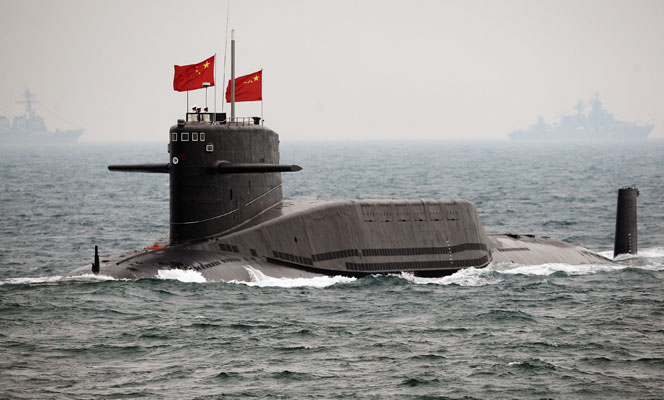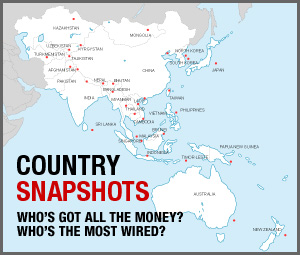The Next Arms Race

Japan’s Maritime Self-Defense Force (MSDF), meanwhile, deploys perhaps the most modern and capable diesel-electric submarine force in the world. Japanese defence planners have kept the fleet at the technological cutting edge by routinely retiring boats well ahead of schedule while introducing ever more capable replacements. Thus, even though the numbers have remained relatively still (at roughly 16 boats) over the past decade, the MSDF has maintained an impressively high proportion of advanced submarines. For example, the latest class of submarines, the Soryu, is superior to its predecessor by virtually every index of performance. The Soryu is the first Japanese boat fitted with air-independent propulsion (AIP), a fuel-cell technology that permits submarines to operate underwater for extended periods while quieting their noise signature. It is a formidable undersea platform. In short, the MSDF leads the region in conventional submarine warfare–constituting the benchmark against which other Asian navies will be compared against over the next decade.
Sea-lane defence occupies a dominant place in Japanese naval thinking. Potential disruptions to seaborne traffic, the lifeblood of the Japanese economy, represent a threat to national survival. One need look no further than the bitter lessons of World War II. During the Pacific War, the US Navy sent over 1,100 Japanese merchantmen to the bottom, reducing the home islands to the brink of mass starvation. At the peak of the Cold War in the 1980s, the Japanese submarine force took up blocking positions along the first island chain, detecting and tracking Soviet submarines that sought access to the Pacific. Many Soviet skippers opted to remain safely within the Sea of Japan rather than run the risk of being sunk in the event of an outbreak of hostilities. Given the economic and strategic imperatives confronting Tokyo, it’s unsurprising that undersea craft rank near the top of Japan’s defence priorities, and will do so for years to come.
The Chinese Navy too boasts a long pedigree in undersea warfare. Swayed by Soviet naval orthodoxy, the People’s Liberation Army Navy (PLAN) devoted virtually all of its attention to coastal defence, a function for which submarines are well suited. Maoist China’s landward orientation and defensiveness at sea reinforced this predilection for undersea combat. Following its quixotic 1950s struggle against Taiwanese and US forces over offshore islands, Beijing transfixed its strategic gaze upon defeating a potential seaborne invasion of the mainland. The submarine force–in conjunction with coastal patrol boats–thus became the first line of homeland defence and an adjunct to army operations. The Chinese naval force structure throughout the Cold War bore witness to this priority and by the 1980s, Beijing had not only put to sea nuclear-powered submarines but also boasted the largest undersea fleet in Asia.
Today, China’s submarine force labours under the weight of this Cold War legacy. The vast majority of the fleet, reverse-engineered from Soviet models of the 1950s and 1960s, is obsolete by Western standards. Yet age is only one measure of effectiveness. A well-placed submarine, even a rickety one, could lie in wait and ambush passing enemy vessels. The 1996 Taiwan Strait crisis, during which President Bill Clinton dispatched two carrier groups as a show of force, is illustrative. As the cross-strait confrontation reached its climax, US defence planners fretted over Beijing’s capacity to deploy much of its undersea fleet to waters near the island. Despite the operational and technological superiority of the US Navy to its Chinese counterpart, American naval commanders nevertheless viewed the potential PLAN deployment with genuine alarm.
Why? US antisubmarine warfare (ASW) is an operational art that atrophied from neglect in the post-Cold War period. ASW remains one of the most demanding missions facing any navy. The burden falls disproportionately on the side that must seek, find and destroy submarines to guarantee an acceptable margin of safety at sea. By contrast, the clever submariner only needs to ensure that a single torpedo reaches a primary target to wreak physical and psychological havoc on the enemy fleet. The asymmetric nature of undersea warfare means that no commander worth his salt takes a submarine threat lightly–however antiquated the enemy boats might be. The sheer number of Chinese submarines magnifies this lopsidedness.
Beijing embarked on a naval modernization program more than a decade ago that is remaking the submarine fleet. In the 1990s, the Chinese purchased two batches of Russian-built Kilo-class diesel-electric submarines armed with deadly wake-homing torpedoes, which seek out the turbulence created by ship propellers and are extraordinarily difficult to evade. Kilos also sport land-attack cruise missiles and antiship cruise missiles. Once thought to be a failing program due to technical difficulties, the indigenous Song-class diesel attack submarine entered serial production early this decade. Attesting to the impressive advances in China’s industrial-military complex, these capable submarines have been built at a rapid pace of two per year. The Yuan-class diesel attack boat made its debut in 2004 to the apparent surprise of the US intelligence community. The Yuan reportedly incorporates the best features of the Kilo and the Song and may even be equipped with indigenously designed air-independent propulsion. The expected entry of the next-generation Shang-class SSNs will add even more striking power to the fleet.
These four classes of modern attack boats already constitute a third of China’s entire undersea force. Over the next decade, as the PLAN commissions new platforms, the majority of its submarines will be modern. In all likelihood, the navy will reverse the steep decline in the overall quantity of its fleet by 2015, as it completes the mass retirement of older hulls. By 2020, then, the fleet will not only be newer but will have made up for the deep cuts in the inventory that began with the end of the Cold War.










